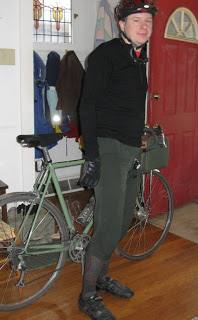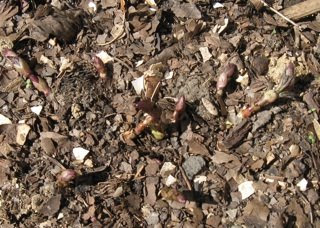A play in 3 acts
A year or so ago, Kent Petersen asked a question on his blog: Why do you commute by bike? I thought about this, but realized that it wasn’t that simple. Why I commute now is not the same as how I started commuting, or why I didn’t stop.
It’s getting to be bike commuting season for non-crazy cyclists. Maybe this will be inspiring to someone?
Act One: The Beginning
I think it was in the summer of 2005, when I decided I’d take Martine out for a bike ride in her trailer. I wasn’t cycling very much then, but I felt like I should get in better shape so I could be more active with Martine.
In those days we still had a garage. I opened the door, but my bike was gone: it was stolen. Bummer! We had another bike, but the only trailer attachment I had was on the stolen bike. That ruined the afternoon’s plans, and I had to file an insurance claim. (For future reference: before you file an insurance claim, find out what your deductable is, or you may do a lot of work for nothing.)
I really didn’t like the other bike I had. I wanted a new one. But I didn’t ride enough to justify buying a new one. So I decided that to prove I would use a bike enough to make it worth buying one, I’d start riding my bike to work.
So, one weekend shortly after that I rode a test route to work and back. It was horrible in almost every way possible. I rode both ways at once without a break; it was about 14 hilly miles. I chose a bad route, basically the opposite direction from how I go now. Riding across the Swinburne bridge and up the hill, I ended up dry heaving in the Sestili Nursery parking lot from too much effort. I then went onto Boulevard of the Allies, and rode up the hill where the cars speed by very quickly, in 2 lanes with no shoulders.
But, I did it. I learned that I needed to choose a better route, but more importantly, I learned that I could do it.
Riding to and from work was a easier than riding both ways at once, especially when I found better routes, but it was still very challenging. It seemed like every time I rode, it was easier than the last time. This part of the practice/performance curve is the perfect environment for a Jack of All Trades: small investments in time reap large improvements in performance. It’s really fun to get better quickly, but you eventually hit a ceiling, where improvement becomes increasingly difficult.
In the mean time, I researched the kind of bike I wanted to buy. I settled on a touring bike as being the right match for my needs: cargo capacity, sturdy enough to ride on potholes, but optimized for riding on the road and for comfort. I researched the new models I might be interested in, as well as some well-regarded older touring bikes.

Eventually, a 1985 Trek 620 came up on craigslist for $50, and I drove to Ohio in the Insight to snatch it up. It had some original parts, but was also a bit frankensteined for commuting use. I butchered it up a bit more, and started riding it instead of my other bike.
I loved it! I liked riding it, and I liked working on it. I didn’t really want a new bike anymore, after that… but more old ones might not be so bad. The good thing about getting old bikes was that it allowed me to try a lot of things, before deciding what I liked best.
It turns out this wasn’t the best bike for me. It wasn’t really the right fit or geometry, and it was overall quite ugly. I traded the frame and fork for another Trek which I still ride; and some of the other components are still in use on my various bikes. Considering the use I’ve gotten out of its parts, that original Trek was probably one of the most effective $50 I’ve ever spent on bikes.
Act Two: Making Lemonade
I kept on biking to work, but not every day. I didn’t ride in the rain. Or really, I didn’t ride when I thought it was going to rain, which turned out to be a lot more often than when it was actually raining. I stopped riding when the forecast was “too cold,” which might have meant in the 40’s.
At one point, I ran into Daniel on the way home from work. He also works in South Side and lives in the east end. I didn’t know he rode to work. I had a lot of questions, since he seemed a lot more experienced with this whole “bike to work” thing. “Do you ride when it’s cold? Do you ride when it’s wet?” Those things seemed reserved for crazy people. He rode more in the cold than the wet. He was also a lot faster than I was. He was trying to have a conversation with me, while I could only huff and puff in response, if I wanted to keep up. It was quite inspiring.
Around 2006, some pivotal events started shaping my bicycle commuting. They shut down some lanes on the Birmingham Bridge to refurbish it. Then, they started work on the bike/pedestrian span of the Hot Metal Bridge, which required obstructing traffic on the car span. pair Networks, where I work, is situated directly between these two links from South Side to the north side of the river. When one of them was closed, traffic was really screwed up. When both closed, it was pure hell.
By this point, riding to work took a bit of effort, it was harder than driving; but it was really not a challenge anymore. The construction made it so painful to drive that I drove less and less, and rode more and more. Riding became easier and easier, and driving became harder and harder.
I also started to get crazy. I started riding even though it might rain, because usually it didn’t. I bought rain clothes so I wouldn’t get wet even if it did rain. It turns out that if you’re prepared for the weather, it’s really not that difficult or uncomfortable to ride in. I got a headlight to ride after daylight savings time, and fenders to keep myself dry. Little by little, I replaced all those parts we all tore off our bikes when we were kids because they weren’t cool.
Act Three: Deciding Not To Decide

In February of 2007, Marla got in a car accident, and the Honda Insight was totalled. She broke her back, and we didn’t have or need two cars for a while. When it came time to figure out the “car” situation, we weighed our options. At that point, just living with 1 car didn’t seem like a viable option.
We bought another Honda, a used Civic. I enjoyed it even more than the Hyundai we still have. But the traffic was still horrible. I rarely drove to work at this point. I realized I didn’t need to drive to work anymore, and then I decided I wasn’t going to drive to work anymore.
Deciding not to drive gets its own act, because it made a big impact on my riding, and on my frame of mind. By deciding not to drive, I made one decision to ride, instead of making a new decision every morning. Those small decisions waste time and energy thinking about things that are unimportant.
After I decided not to decide, riding became easier. It’s easy to drive to work, if that’s “just what you do.” You don’t think about the alternatives, you just do it and get to work. It’s routine. No problem. The transition between two different routines causes strife: which way do you want to do it today? Once I decided on a new routine and settled into it, things became easy again.
Then, Marla and I started paying attention to how often we used both cars at the same time, and how often we “needed” both cars at the same time. It turned out that even without making an effort to change our behavior, we almost never used two cars. When we did use two cars, it was almost always an unnecessary impulse trip. When we sold the Honda in February 2008, we had put less than a thousand miles on it. We became a single car family, instead of just a single driver family.
We’ve had one car for a bit over a year now, and I have no regrets other than “we should’ve done it sooner,” or “we never should’ve bought the Civic.” I don’t enjoy driving, Marla does almost all the driving even when I’m there.
The cost savings of having only one car is huge. Just the price of auto insurance for a year would buy me a more expensive bike than I’ve ever bought all in one piece (but don’t ask me to add up the price of all those parts). We’ve had other benefits, like not being tempted to go on impulse shopping trips. I suppose it could be considered inconvenient sometimes, but at this point I’m back to being used to having only one car, so it’s just “normal.”
Epilogue
I don’t expect everyone, or really anyone, to do what I’ve done. It’s not my intent to scare people away from commuting by bicycle because they don’t want to do it all the time. The most important point I should make is that I’m sure I never would have commuted by bike if it wasn’t fun.
Don’t feel the need to take every opportunity to ride instead of driving. Instead, remember that any time you can ride a bike instead of driving is a chance to have fun, improve your health, do less damage to the environment, and spend less money.
“Deciding not to decide” doesn’t mean “deciding not to drive.” It means setting clear, measurable criteria, and sticking to them. My rule was “I don’t drive to work.” Someone else might decide “I’ll ride instead of driving if I’m going less than 2 miles and it’s not raining.” Even this small commitment can provide the benefits of “deciding not to decide,” if you stick with it and allow it to become routine.
Have a good ride!
 This is a sketch of the rodback chair. I made it before I started working on the chair using tracing paper over a photograph of the chair I was inspired by. I changed things where necessary to show the chair I planned to build.
This is a sketch of the rodback chair. I made it before I started working on the chair using tracing paper over a photograph of the chair I was inspired by. I changed things where necessary to show the chair I planned to build. I took a photo of my chair-in-progress, from approximately the same angle as the photo I traced. It looks pretty close!
I took a photo of my chair-in-progress, from approximately the same angle as the photo I traced. It looks pretty close! Today I trimmed the spindles. If it weren’t for the unfortunate crack, it would be basically ready for a quick sanding and a few coats of paint.
Today I trimmed the spindles. If it weren’t for the unfortunate crack, it would be basically ready for a quick sanding and a few coats of paint.







